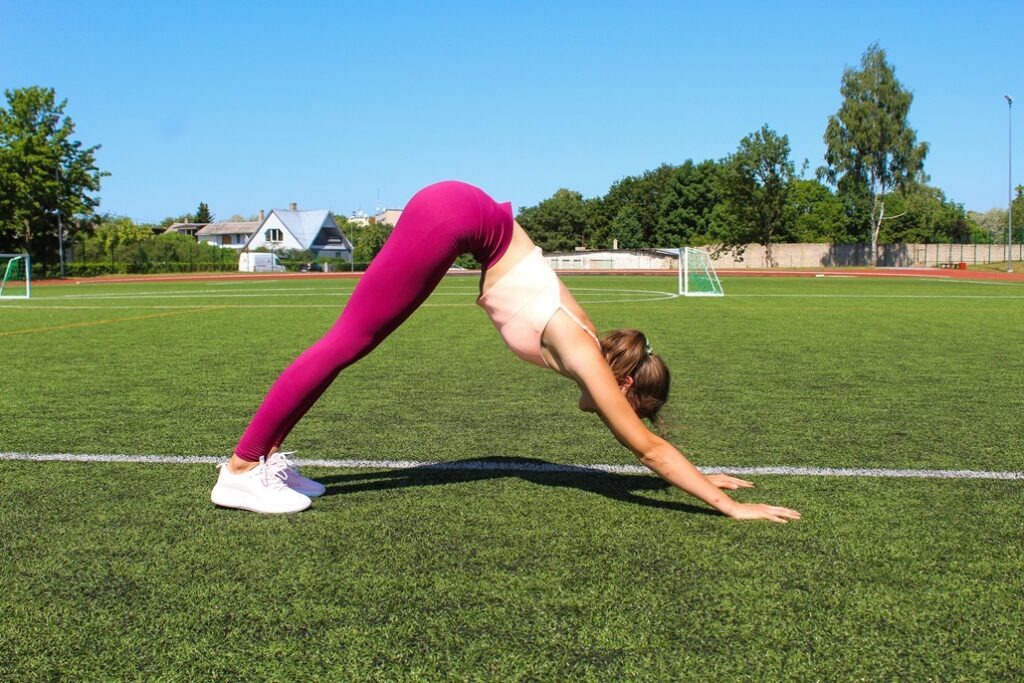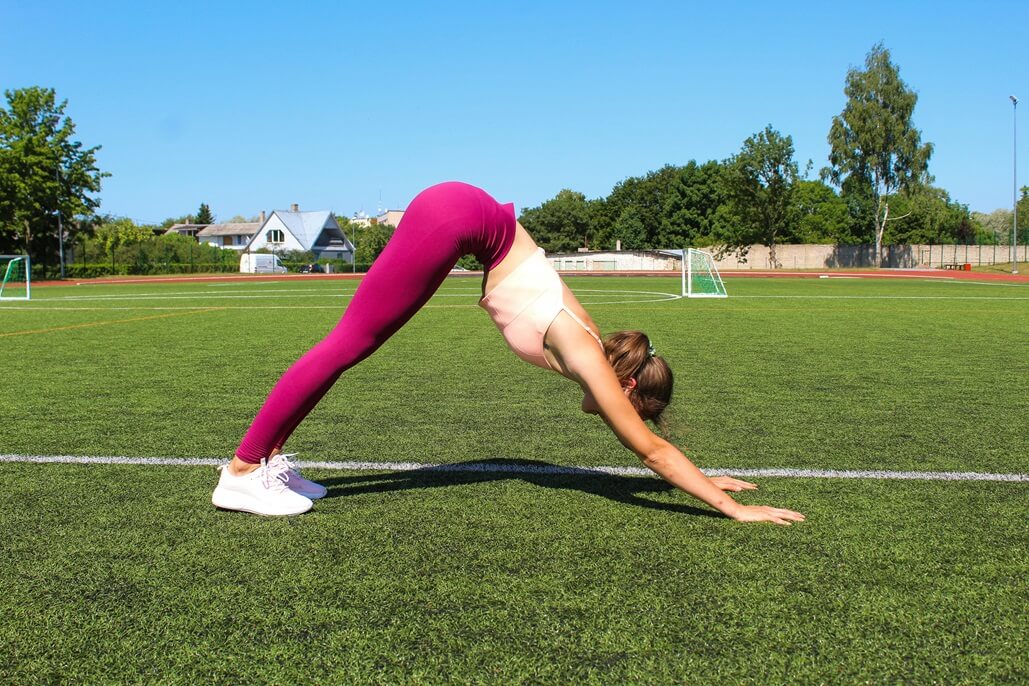Experienced yogis understand the significance of Adho Mukha Svanasana, commonly known as Downward Dog Pose, in their practice. This iconic yoga pose offers a myriad of benefits for the mind and body when performed with proper alignment and technique. From strengthening the arms and legs to improving digestion and relieving stress, mastering this pose can improve overall health and well-being. However, incorrect execution may lead to strain on the wrists and shoulders, making it essential to learn the correct form and alignment to safely unleash the powerful benefits of Downward Dog Pose.

Key Takeaways:
- Alignment is key: Pay attention to the alignment of your body to avoid putting pressure on the wrists and shoulders. Keep your hands shoulder-width apart and feet hip-width apart to maximize the benefits of the pose.
- Stretch and strengthen: Downward Dog pose is an excellent way to stretch and strengthen the entire body, including the arms, shoulders, back, and legs. Focus on maintaining a straight spine and pressing your heels towards the ground to get the most out of the stretch.
- Breathe and relax: Use deep, steady breaths to help release tension throughout the body while in the pose. Let go of any tension in the neck and shoulders, and aim to relax into the stretch for a more rejuvenating experience.
Other Benefits:
- This Pose is crucial for spine elongation and shoulder stability.
- Downward Dog engages multiple muscle groups for strength building.
- It improves flexibility in hamstrings, calves, and entire back.
- It helps to calm the mind and relieve stress.
- Modifications can adapt the pose for different body types.
- Consistent practice leads to improved posture and circulation.
The Anatomy of Adho Mukha Svanasana
The Adho Mukha Svanasana, also known as the Downward Dog Pose, is a foundational yoga asana that offers a plethora of physical and mental benefits. To truly master this pose, it’s essential to understand the anatomy and the muscles involved in its practice.
Muscles Involved in the Pose
To execute the Adho Mukha Svanasana effectively, various muscle groups come into play. The primary muscles engaged include the hamstrings, calves, shoulders, arms, back, and core muscles. As the body forms an inverted V-shape, the hamstrings and calves experience a deep stretch, while the shoulders and arms bear considerable weight to support the upper body. Additionally, the engagement of the core muscles helps in maintaining stability and balance throughout the pose.
Furthermore, the trapezius muscles of the upper back and latissimus dorsi are also involved in the Adho Mukha Svanasana, aiding in the extension and stability of the spine. It’s important to note that practicing this pose regularly can help strengthen and tone these muscle groups, leading to improved overall body strength and stability.
Physical Benefits of Practicing Downward Dog
Svanasana regular practice of Adho Mukha Svanasana offers an array of physical benefits. This pose stretches and strengthens the entire body, improving flexibility in the hamstrings, calves, shoulders, and spine. Additionally, it stimulates the digestive system and relieves headaches, fatigue, and insomnia. Adho Mukha Svanasana also helps to increase blood circulation throughout the body, promoting overall health and vitality.
The pose is known to relieve tension in the neck and shoulders while strengthening the arms and legs. It also improves posture and concentration, making it a beneficial pose for those leading a sedentary lifestyle or working long hours at a desk.
Moreover, regular practice of Adho Mukha Svanasana can aid in preventing osteoporosis by strengthening the bones and improving bone density. It also helps in reducing anxiety and stress, promoting mental well-being and clarity.
Step-by-Step Guide to Mastering the Pose
After understanding the benefits and potential risks of Adho Mukha Svanasana, let’s delve into the step-by-step guide to master this pose. Below is a detailed breakdown of preparatory poses, detailed instructions for entering and holding the pose, common mistakes, and how to avoid them.
| Preparatory Poses for Flexibility and Strength | Detailed Instructions for Entering and Holding Adho Mukha Svanasana |
| Common Mistakes and How to Avoid Them |
Preparatory Poses for Flexibility and Strength
The journey to mastering Adho Mukha Svanasana begins with preparing the body through a series of poses that enhance flexibility and build strength. The preparatory poses include Balasana (Child’s Pose), Bitilasana (Cow Pose), and Uttanasana (Standing Forward Bend).
The practice of these preparatory poses will help loosen up the spine, open the shoulders, and stretch the hamstrings, ultimately making it easier to transition into Adho Mukha Svanasana with ease and stability.
Detailed Instructions for Entering and Holding Adho Mukha Svanasana
Preparatory to entering Adho Mukha Svanasana, it is imperative to focus on proper alignment and engagement of muscles. Detailed instructions involve setting the hands shoulder-width apart, spreading the fingers wide, grounding the palms firmly, and lifting the sitting bones towards the ceiling.
Step-by-step details of holding Adho Mukha Svanasana include maintaining a straight spine, lengthening the back of the legs, and keeping a strong connection between the hands and the mat. Alignment and engagement are crucial to experience the full benefits of this pose while reducing the risk of injury.
Step-by-step, consistent practice of these instructions will not only lead to the mastery of Adho Mukha Svanasana but also unlock its numerous physical and mental benefits, including improved circulation, strengthened arms and legs, and relief from stress and anxiety.
Common Mistakes and How to Avoid Them
One common mistake in Adho Mukha Svanasana is allowing the shoulders to collapse and the chest to sink towards the floor, leading to unnecessary strain on the wrists and shoulders. Another common mistake is letting the heels lift off the ground, which can compromise the stability and alignment of the pose.
Any practitioner should be mindful to engage the shoulders, press the chest towards the thighs, and keep the heels grounded to avoid the common mistakes and fully experience the benefits of Adho Mukha Svanasana.
The Mental and Spiritual Benefits of Downward Dog
Unlike some yoga poses that focus solely on physical benefits, Downward Dog offers a wide range of mental and spiritual advantages. Incorporating this pose into your regular practice can have a profound impact on your overall well-being, helping to cultivate mental clarity and spiritual connection.
Enhancing Mental Clarity and Stress Relief
Enhancing mental clarity and stress relief are two primary benefits of practicing Downward Dog. This rejuvenating pose allows for increased blood flow to the brain, helping to improve focus and concentration. In addition, the inverted nature of the pose can calm the mind and release tension stored in the body, making it an effective tool for stress relief. When practiced regularly, Downward Dog can significantly reduce anxiety and promote a sense of calmness and mental clarity.
Downward Dog’s Role in Meditation and Mindfulness Practices
An essential part of many yoga sequences, Downward Dog serves as a crucial component in meditation and mindfulness practices. The posture allows practitioners to connect with their breath while simultaneously grounding themselves through the contact with the earth. This combination enhances the mind-body connection, making it easier to quiet the mind and be present in the moment during meditation and mindfulness practices.
As a result, incorporating Downward Dog into your meditation and mindfulness routine can deepen your practice and enhance your spiritual connection with yourself and the world around you. It provides a physical and mental foundation for these practices, ultimately leading to greater self-awareness and inner peace.
Integrating Adho Mukha Svanasana into Your Yoga Routine
To truly master Adho Mukha Svanasana, it is essential to seamlessly integrate it into your regular yoga practice. This not only allows you to fully reap the benefits of this powerful pose but also ensures a balanced yoga routine that enhances overall strength, flexibility, and mindfulness.
Incorporating the Pose into Various Yoga Flows
Mukha Svanasana can be incorporated into various yoga flows to create a dynamic and well-rounded practice. Whether you prefer a slow and gentle vinyasa flow or a more intense power yoga sequence, integrating Downward Dog into your routine offers an opportunity to transition between different asanas with grace and fluidity. This not only improves the overall flow of your practice but also enhances your body awareness and breath control.
Modifications and Variations for Different Skill Levels
Svanasana offers modifications and variations to cater to practitioners of all skill levels, making it accessible for beginners and challenging for advanced yogis. Whether you need to use props to support your alignment, or you’re looking to explore more advanced variations such as one-legged Downward Dog or transitioning into other arm balances, there are options to suit your individual needs. Your practice can evolve over time, allowing you to continually challenge yourself and experience the full range of benefits that Adho Mukha Svanasana has to offer.
Your physical practice and mental focus will be strengthened through consistent attention to proper alignment and engagement. It is important to maintain awareness of your body, breath, and alignment throughout the pose, ensuring that you are keeping the integrity of the pose while avoiding potential strain or injury. Any modifications or variations should be approached with mindfulness and respect for your body’s limitations, gradually increasing intensity when appropriate.
Advice for Maintaining Consistency and Progress
Various factors can impact your ability to maintain consistency and progress in mastering Adho Mukha Svanasana. Incorporating the pose into every practice, setting specific goals for improvement, and being consistent with your alignment and engagement are crucial for progressing in this asana. Additionally, cross-training with other yoga poses and complementary exercises can help address any weaknesses and imbalances, which ultimately supports your progress in Downward Dog.
Any lack of consistency or progression can be a result of improper technique, lack of focus, or not building enough strength and flexibility in the necessary muscle groups. It is essential to prioritize proper form and mindful practice to avoid plateauing or risking injury. With dedication and the right approach, you can steadily progress in your mastery of Adho Mukha Svanasana.
Summing up
Taking this into account, mastering Adho Mukha Svanasana, or the Downward Dog Pose, can significantly benefit both the mind and body. This popular yoga pose helps improve flexibility, strength, and balance, while also relieving stress and anxiety. By regularly practicing and perfecting this pose, individuals can better unleash its full range of benefits, such as improved circulation, posture, and digestion. It is essential to approach this pose with patience and proper alignment to avoid strain and injury, but with dedication and perseverance, the rewards of mastering Adho Mukha Svanasana are well worth the effort.
FAQ
Q: What is Adho Mukha Svanasana?
A: Adho Mukha Svanasana, also known as Downward-Facing Dog Pose, is a popular yoga pose that involves an inversion of the body. It is typically done as part of a yoga flow or sequence and is known for its ability to stretch and strengthen various parts of the body.
Q: What are the benefits of practicing Adho Mukha Svanasana?
A: Adho Mukha Svanasana offers numerous benefits, including stretching the shoulders, hamstrings, calves, and arches of the feet. It also helps to strengthen the arms and legs, improve digestion, relieve back pain, and energize the body. Additionally, it can help calm the mind and relieve stress and mild depression.
Q: How can I master Adho Mukha Svanasana?
A: To master Adho Mukha Svanasana, it’s important to focus on proper alignment and breathing. Start by coming into a tabletop position, then tuck your toes and lift your hips up and back, straightening your arms and legs to create an inverted V shape. Press down through your hands and feet while lengthening your spine. Engage your core and relax your neck and head. Practice regularly and listen to your body to avoid overexertion.

